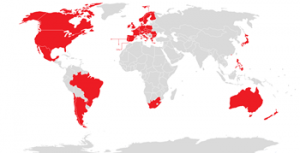Using maps to present data is hardly a new phenomenon. Even modern Geographic Information Systems (GIS) have been around for decades, albeit in their own little bubble. These systems, while incredibly useful, required special training and were rarely used outside of niche companies. In recent years though, due to the big data explosion, many new data types have sprung up, often with their own geospatial element attached. The time has come for businesses to make use of this spatial data.
 While traditional GIS had a steep learning curve, says Ed Burns writing for Tech Target, today’s tools are more modern, user friendly, and much more visually appealing. Much of the software built today is web-based, using Java and HTML.
While traditional GIS had a steep learning curve, says Ed Burns writing for Tech Target, today’s tools are more modern, user friendly, and much more visually appealing. Much of the software built today is web-based, using Java and HTML.
This means they are instantly accessible to most programmers, and they can easily handle development jobs. Furthermore, the web-based front-end interface is a familiar format for non-technical users.
The key for vendors is to create easy-to-use software. A recent Forbes review of location-based intelligence software found that vendors are increasingly pitching their products towards the less technical end of the market. With many tools now suitable for use by non-technical users. Using simpler tools has the effect of pushing location analytics throughout an organization to workers who traditionally had little to do with the field. This makes for better decisions at all levels in the business.
For example, insurance companies can use location intelligence to assess member-specific risks rather than making generalizations based on whole cities or zip codes. Another example is sales departments using it to target potential customers and ensuring workers are optimally distributed. The big change is that the technology has become more consumerized and user friendly.
However, the new generation of location intelligence tools is still developing and there are still big hurdles. For one, it can be difficult to connect location-based intelligence software to traditional business intelligence reporting tools. This can mean wrestling with pre-built connectors with limited functionality or just building their own.
- GIS has been around for decades but until now was very technical
- Over the years, more data has been tagged with location
- Vendors are now pitching location intelligence products to the non-technical crowd
Big Data and related technologies – from data warehousing to analytics and business intelligence (BI) – are transforming the business world. Big Data is not simply big: Gartner defines it as “high-volume, high-velocity and high-variety information assets.” Managing these assets to generate the fourth “V” – value – is a challenge. Many excellent solutions are on the market, but they must be matched to specific needs. At GRT Corporation our focus is on providing value to the business customer.



